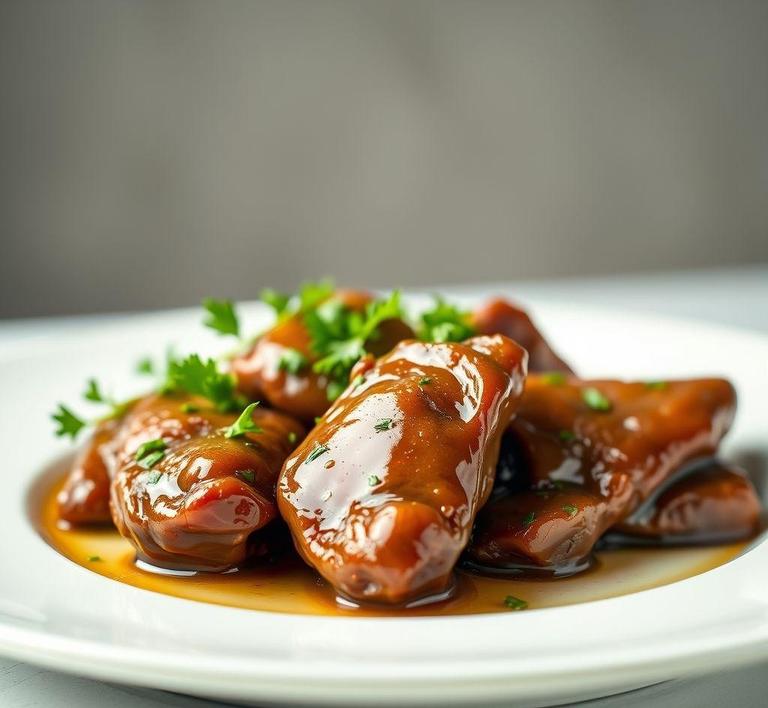If you’ve ever found yourself with extra chicken livers and wondered if it’s safe to refreeze them, you’re not alone! Whether you bought too much or prepared a dish only to realize you didn’t need all the livers, it’s important to know the right way to handle them. Refreezing chicken livers isn’t always the best option, but it’s possible if you do it correctly. In this guide, we’ll walk you through everything you need to know about refreezing chicken livers safely, including how to store them properly, when it’s okay to refreeze, and tips on maintaining their flavor and texture after freezing.
Can You Refreeze Chicken Livers?

When it comes to handling chicken livers, the question of whether or not you can refreeze them is a common one, especially given how delicate and perishable poultry can be. The short answer is yes, you can refreeze chicken livers-but the process isn’t without its nuances. To properly refreeze chicken livers, it is crucial to understand the risks and the proper methods that ensure the meat stays as safe and high quality as possible.
Refreezing any food, including chicken livers, involves a series of important factors to prevent contamination and ensure the product remains edible. It’s essential to address the conditions under which the livers were thawed and whether they were properly handled throughout the process. In essence, chicken livers, like all frozen meat, should not be refrozen unless they were first thawed in the refrigerator, or another safe environment, and have not been left at room temperature for more than two hours (or one hour if the temperature is above 90°F / 32°C).
If you follow these guidelines, refreezing is entirely safe from a food safety perspective, but the quality of the livers may still be affected. More on that in a moment!
How To Refreeze Chicken Livers?
Refreezing chicken livers can be done, but it must be approached with care. Here’s a step-by-step breakdown of how to do it correctly:
- Thaw Safely: The first step is ensuring that the chicken livers are thawed properly. The best method is to let them thaw in the refrigerator for 24 hours. This keeps the livers at a safe temperature throughout the thawing process, preventing the growth of harmful bacteria.
- Check for Quality: Once the livers have thawed, it’s essential to assess their quality. If they have an off smell, unusual texture, or any signs of spoilage, do not attempt to refreeze them. Use your judgment-if anything seems off, discard the livers.
- Reseal and Repackage: Before refreezing, make sure that the chicken livers are well-wrapped to avoid freezer burn, which happens when the meat is exposed to air and dries out. If you originally bought the livers in a vacuum-sealed package, you can simply re-vacuum-seal them. Otherwise, wrap them tightly in plastic wrap, followed by aluminum foil, or place them in a heavy-duty freezer bag. Be sure to squeeze out any excess air from the bag to minimize the risk of freezer burn.
- Label and Date: One of the most important steps is labeling your package with the date. Chicken livers should ideally be used within 3-4 months of refreezing, as the quality can degrade over time.
- Freeze Quickly: Once the chicken livers are properly sealed, place them in the coldest part of the freezer. The faster they freeze, the better they will retain their texture and flavor. If your freezer has a fast-freezing option, use it.
- Avoid Multiple Refreezing Cycles: After the first refreeze, it’s best not to thaw and refreeze the livers again. Each cycle increases the risk of bacterial growth and degrades the overall quality of the meat. If you don’t plan to use the entire batch of livers once they are refrozen, consider dividing them into smaller portions before freezing.
Quality Impact
The quality of chicken livers can certainly be impacted by the process of freezing and refreezing. When chicken livers are frozen, their cell structure is affected by the formation of ice crystals, which can rupture the cells. When thawed, the texture of the livers may become slightly more watery and less tender. This is a natural consequence of freezing, but it’s manageable.
However, when chicken livers are refrozen, the damage to their texture and flavor becomes more pronounced. The reason for this is that the process of freezing and thawing multiple times allows more ice crystals to form and damage the tissue, leading to a mushier texture. Additionally, if livers were thawed at room temperature or exposed to warm conditions for too long, the risk of bacterial growth increases, which can further compromise the safety and taste of the meat.
Another issue with refreezing is that the livers might lose some of their flavor. This is due to the breakdown of certain compounds during the freezing and thawing cycles. The flavor may become less fresh or even slightly metallic, depending on how the livers were handled. While refrozen chicken livers are still safe to eat as long as they were thawed and handled properly, they may not have the same rich, smooth flavor as freshly frozen or fresh livers.
While you can refreeze chicken livers, it’s important to do so carefully. The most important consideration is food safety-never refreeze chicken livers that have been left out at room temperature for extended periods. Always thaw the livers in the refrigerator and avoid multiple cycles of freezing and thawing. While it’s safe to refreeze as long as these guidelines are followed, you may notice some changes in texture and flavor.
If you’re planning on using chicken livers within a few days, it’s better to store them in the fridge rather than freezing them. Refreezing should be a last resort, especially when preserving the highest quality of the meat is a priority. Ultimately, by following proper procedures, you can still enjoy chicken livers after they’ve been refrozen, though it’s wise to set your expectations regarding texture and flavor.
Is It Safe To Refreeze Chicken Livers?
Refreezing chicken livers is a topic that generates some debate in the culinary world. In general, the safety of refreezing chicken livers depends on the conditions under which they were initially frozen, thawed, and stored. When chicken livers are first frozen, the goal is to lock in freshness, preserve texture, and inhibit bacterial growth. However, the risk lies in what happens when they thaw.
Thawing chicken livers should always be done safely-preferably in the refrigerator, which keeps them at a safe, low temperature. If you thaw chicken livers at room temperature or leave them out for extended periods, bacterial growth can occur rapidly. When chicken livers are refrozen after this unsafe thawing process, harmful bacteria that may have started multiplying can be trapped and may pose a serious health risk.
However, if chicken livers are thawed safely (in the fridge) and have not been left out at unsafe temperatures for more than a couple of hours, they can be refrozen-but with caution. The texture and quality of the livers may degrade after being frozen, thawed, and refrozen, and the chances of freezer burn are higher with multiple freeze-thaw cycles. This means while it’s technically safe, it is not recommended unless absolutely necessary.
Signs That Chicken Livers Should Not Be Refrozen
There are several signs that indicate chicken livers should not be refrozen, particularly if they have been improperly thawed or mishandled during the freezing process. Here are the main indicators:
- Off-Putting Odor: One of the clearest signs that chicken livers should not be refrozen is a foul or sour odor. If the livers smell rotten or overly pungent, this is a sign that bacterial growth has already taken place. Refreezing them would not make them safe to eat.
- Discoloration: Chicken livers that have changed color from their usual reddish-brown to a dull gray or greenish hue should be discarded. This color change suggests that the livers have been sitting in a compromised temperature zone, allowing bacteria to grow, or have been exposed to air for too long.
- Slimy or Sticky Texture: Chicken livers should have a firm, smooth texture when fresh. If they feel sticky or slimy to the touch, this is an indication that they have started to spoil. Even after thawing in the fridge, the texture can change if they were not properly handled, and refreezing them would only exacerbate the problem.
- Temperature Abuse: If chicken livers were thawed at room temperature or left out for an extended period (more than two hours), bacteria have likely begun to multiply, and refreezing them would not eliminate the risks. Even if refrozen, the risk of foodborne illness remains high.
- Visible Ice Crystals or Freezer Burn: Freezer burn results from air exposure and moisture loss in the freezer. It leads to dry, tough spots on the surface of the livers. While freezer-burned livers may still be safe to eat (albeit dry and unpleasant), their texture and flavor will suffer upon refreezing.
Common Refreezing Mistakes
When it comes to handling frozen chicken livers, people often make several mistakes that can compromise both safety and quality. Here are a few common errors to avoid:
- Thawing Improperly: One of the most common mistakes is thawing chicken livers at room temperature. Thawing meat in this way can cause the outer layers to warm too quickly, which creates the ideal breeding ground for bacteria. Always thaw chicken livers in the refrigerator or, if you’re in a rush, use the microwave for a quick defrost.
- Not Using Proper Storage Containers: If chicken livers are refrozen without being properly wrapped or sealed in airtight containers or freezer bags, they can develop freezer burn. This happens when air comes into contact with the food and moisture is lost. Wrapping them in plastic wrap and placing them in a sealable plastic bag can help prevent this.
- Repeated Freeze-Thaw Cycles: Every time you thaw and refreeze chicken livers, they lose moisture, which results in an increasingly dry and tough texture. Freezing and thawing multiple times can cause the liver to become rubbery and lose its original taste. It’s better to only thaw and refreeze if absolutely necessary.
- Freezing When Fresh: Another mistake people sometimes make is freezing chicken livers when they are not fresh, assuming that freezing will preserve them. If the livers were already on the verge of spoiling, freezing them will only lock in that deteriorating quality, making them unsafe or unpalatable once thawed.
- Not Labeling: One simple mistake that many people make is failing to label their frozen foods with the date of freezing. If chicken livers are frozen for an extended period without being consumed, even if they haven’t been thawed and refrozen, their quality will begin to degrade. Freezing for too long can lead to loss of texture, flavor, and nutrients.
Tips And Tricks
To ensure the safety and quality of your chicken livers when freezing, thawing, and possibly refreezing them, follow these helpful tips:
- Freeze Right After Purchase: If you don’t plan to use your chicken livers right away, freeze them as soon as possible to preserve their freshness. Freezing livers at peak freshness will help retain their texture and flavor when thawed.
- Use Vacuum Sealing: If you plan to freeze chicken livers for an extended period, vacuum sealing them can reduce air exposure and prevent freezer burn. This method also keeps them fresher for a longer time compared to standard storage bags.
- Thaw in the Refrigerator: Always thaw chicken livers in the refrigerator, as this keeps the temperature consistently low, minimizing bacterial growth. If you need to thaw them faster, you can use the microwave on a low-power setting, but only if you’re planning to cook them immediately afterward.
- Portion Control: To avoid the need for refreezing, try freezing chicken livers in smaller portions. This way, you can take out exactly what you need and avoid thawing and refreezing larger batches unnecessarily.
- Monitor Freezer Temperature: Keep your freezer temperature at 0°F (-18°C) or lower. This ensures that the chicken livers remain at a safe temperature throughout the freezing process, reducing the risk of bacterial growth.
Conclusion
While it is possible to refreeze chicken livers, doing so comes with a set of considerations. The safety of refreezing largely depends on how the livers were thawed and stored initially. If chicken livers have been thawed improperly or have started showing signs of spoilage, they should not be refrozen under any circumstances.
For those who choose to refreeze, it’s crucial to follow proper handling guidelines, including ensuring they’re thawed in the refrigerator and re-wrapped in airtight containers to prevent freezer burn. To maintain the best texture and flavor, it’s wise to limit the number of times chicken livers go through the freeze-thaw cycle.
In summary, while refreezing chicken livers is technically safe under the right conditions, it’s not recommended for maintaining optimal quality. For the best results, freezing and consuming them promptly, with proper care, is the key to a safe and enjoyable culinary experience.


